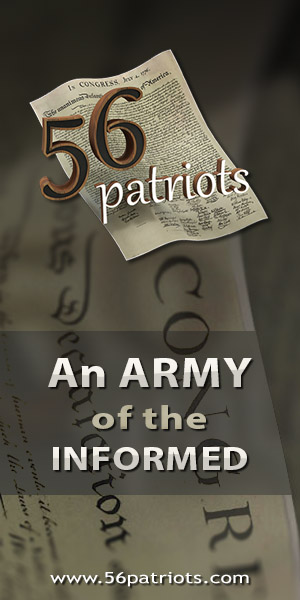The First Amendment Guarantees ALL Freedoms, including a Truthful Press
ROTC and the Ivies
Published: Thursday, March 30th, 2023 @ 8:45 am
By: James G. Martin Center for Academic Renewal † ( More Entries )
By: James G. Martin Center for Academic Renewal † ( More Entries )
Publisher's Note: This post appears here courtesy of The James G. Martin Center. The author of this post is Gordon Bare.
Ivy League universities have a distinguished history of their students serving the country in the armed forces. Yale can claim Captain Nathan Hale, class of 1773, executed by the British as a spy three years later. Benjamin Franklin, principal founder of the University of Pennsylvania, served with distinction in the French and Indian War. Only West Point and Annapolis have more Medal of Honor awardees than Harvard's 18.
College training for military leadership has its roots in the Morrill Act of 1862, which created land-grant colleges and required instruction in "military tactics." Congress legislated the Reserve Officers' Training Corps (ROTC) in 1916, and Harvard was the first college to bring ROTC to campus in that year. By 1918, over 135 colleges, including all Ivies, hosted units. ROTC, with robust programs at the Ivies as well as at a wide range of other universities, provided a high percentage of military officers through World War II and into the 1960s.
At my alma mater, the University of Pennsylvania, ROTC was broadly accepted and conferred academic credit. One could walk the campus in uniform in the mid-1960s without notice being taken. I received an Army commission upon graduation in 1967, a time when the officer corps was more racially diverse than the Penn student body. ROTC at Penn ran afoul of the politics of Vietnam, which peaked with the Cambodian invasion in May 1970. This alleged escalation of the war, together with the approach of semester finals, proved too traumatic for the campus population, and Penn and most other Ivies shut down for the remainder of the school year. Both Army and Navy ROTC were relegated to a quasi-industrial facility off campus. University credit for ROTC coursework was terminated on the dubious grounds that it was insufficiently "academic."
After a return to a degree of tolerance as Vietnam faded, the focus of attacks on ROTC shifted to the military's policies on gays. Army ROTC was expelled from Penn a second time after "Don't Ask, Don't Tell" legislation was passed in 1993 (by a Democratic Congress and the Clinton administration). It was more convenient to blame the armed forces than the politicians who funded the university. Not even 9/11 motivated Penn to reconsider its moral preening. Penn students who take ROTC at other campuses regularly report disdain, ostracism, and hostility from other students, faculty, and the administration. Navy ROTC maintains a mere foothold with single-digit participants. The Army program numbered around 150 in my era; there are now five Penn cadets in the program at nearby Drexel.
Harvard, frequently the Ivy pacesetter, followed a similar trajectory. Sometimes violent demonstrations against ROTC occurred in 1969. Over the next two years, connections with all three service programs-Army, Navy and Marine Corps, and Air Force-were completely severed. Only in 1976 were Harvard students permitted and funded to enroll in neighboring MIT's programs. In 1995, after years of debate and objections by both faculty and students centered on "Don't Ask, Don't Tell," the university ended its funding but permitted an alumni trust fund to cover costs at MIT. In 2022, eight Harvard students received commissions in all services. Participants cite a lack of support from the administration.
Dartmouth, traditionally the most conservative of the Ivies, has had a distinguished military history since as far back as the Revolutionary War. In the 1950s, Dartmouth offered ROTC for all three services and enrolled over 1,000 cadets per year. The Vietnam War brought lockouts, barricades, and arrests. After faculty demands, ROTC programs left Dartmouth by 1971. Under severe alumni pressure, the trustees voted to reinstate it in 1975, with an Army program available at Norwich University an hour away. There are now only 15 or so Dartmouth cadets. Air Force and Navy ROTC are not available.
Columbia's Midshipmen School trained over 23,000 naval officers during World War II. It experienced some of the most violent protests of the Vietnam era, with ROTC as a major target. Columbia students were only approved to take ROTC at other schools in 2011. At the time, petitions by faculty and students opposed ROTC, alleging campus militarization and, nonsensically, discrimination on the basis of physical disability and age. A campus hearing on its return was marred by abuse shouted at a disabled Army veteran.
There are some bright spots, but it has been a slow road back. Princeton hosts a reasonably healthy Army program for its own and other schools' students. Unlike the other Ivies, Army ROTC was continued at Princeton throughout the Vietnam War, in spite of a fire-bombing of its facility. Navy ROTC was terminated at the time and was only reinstated in 2014, with cadets training at Rutgers.
An outfit called the First Yale Unit was started in 1915 by a dozen students in anticipation of America's entry into World War I. It is considered the beginning of American naval reserve aviation, and it provided the first American naval ace of the war. After a 40-year hiatus post-Vietnam, Yale now hosts substantial Navy and Air Force units and won a Defense Department award for its support. Army ROTC is available at the nearby University of New Haven.
Cornell is another honorable exception, with robust programs in all three services enjoying cordial relations with administrators and relatively unaffected by the vicissitudes of leftist politics.
Debate about ROTC on campuses during the '90s and into the new century was further complicated by a series of Congressional actions principally sponsored by Representative Gerald Solomon (R, NY) and passed on a bipartisan basis. These laws denied most federal grants to colleges that failed to allow military recruiting or ROTC as part of their academic programs. There was intense opposition from many universities, particularly the Ivies and their law schools. After much litigation, the so-called Solomon Amendment was unanimously upheld by the Supreme Court in 2006 (in Rumsfeld v. Forum for Academic & Institutional Rights). After that decision, the House of Representatives overwhelmingly passed a resolution confirming its support. There ensued something of a guerilla war, as administrations moved toward a grudging formal compliance while seeking to maintain a self-righteous distance and sometimes tacitly welcoming student and faculty protests against ROTC. Nevertheless, the court decision and the resolution were a major defeat for the universities and a victory for the ideal of broad support for a strong military, honored by civil society.
The repeal of "Don't Ask, Don't Tell" in 2011 led several Ivies to ease their opposition, frequently through permitting student participation in programs with other colleges. In sum, the Ivies have moved to an informal policy of detached tolerance, with at least a few administrators or faculty prepared to offer open support. But with the emergence of transgender issues as the new touchstone of wokedom's agenda, some school administrators have waged a tacit campaign encouraging anti-military demonstrations.
So where does all this leave us? The armed forces have become increasingly divorced from the leading institutions of education and our broader society, with only a modest respite after 9/11. This trend has accelerated as campuses have become increasingly intolerant of any deviation from woke ideology. A high percentage of senior faculty members and administrators are aging Vietnam-era students, some of whom dodged the draft, and many of whom had their politics shaped by that period.
Today, the armed forces face a crisis of recruiting and a broader crisis of public confidence. The travails of ROTC in the Ivies are indicative of a broader belief that American civilization is fatally flawed. Surveys by the Reagan Institute indicate that, in the last five years, Americans' trust in the military has declined from 70 percent to 48 percent. Majorities cite politicization and woke policies, question the competence of both civilian and military leadership, and question the ability to win a future war. A significant number of Republicans have joined in the longstanding inclination of Democrats to cut military funding.
Many small, current ROTC programs can be legitimately challenged on a cost-benefit basis. But the armed forces need the presumed best and brightest, and college students need exposure to servicemen and women, even if they decline to join them. Campuses should go out of their way to make room for ROTC.
Gordon Bare is a retired U.S. Army and State Department officer and a graduate of Penn (College, '67, and Grad. Arts and Sciences, '68).
Go Back
Ivy League universities have a distinguished history of their students serving the country in the armed forces. Yale can claim Captain Nathan Hale, class of 1773, executed by the British as a spy three years later. Benjamin Franklin, principal founder of the University of Pennsylvania, served with distinction in the French and Indian War. Only West Point and Annapolis have more Medal of Honor awardees than Harvard's 18.
College training for military leadership has its roots in the Morrill Act of 1862, which created land-grant colleges and required instruction in "military tactics." Congress legislated the Reserve Officers' Training Corps (ROTC) in 1916, and Harvard was the first college to bring ROTC to campus in that year. By 1918, over 135 colleges, including all Ivies, hosted units. ROTC, with robust programs at the Ivies as well as at a wide range of other universities, provided a high percentage of military officers through World War II and into the 1960s.
At my alma mater, the University of Pennsylvania, ROTC was broadly accepted and conferred academic credit. One could walk the campus in uniform in the mid-1960s without notice being taken. I received an Army commission upon graduation in 1967, a time when the officer corps was more racially diverse than the Penn student body. ROTC at Penn ran afoul of the politics of Vietnam, which peaked with the Cambodian invasion in May 1970. This alleged escalation of the war, together with the approach of semester finals, proved too traumatic for the campus population, and Penn and most other Ivies shut down for the remainder of the school year. Both Army and Navy ROTC were relegated to a quasi-industrial facility off campus. University credit for ROTC coursework was terminated on the dubious grounds that it was insufficiently "academic."
After a return to a degree of tolerance as Vietnam faded, the focus of attacks on ROTC shifted to the military's policies on gays. Army ROTC was expelled from Penn a second time after "Don't Ask, Don't Tell" legislation was passed in 1993 (by a Democratic Congress and the Clinton administration). It was more convenient to blame the armed forces than the politicians who funded the university. Not even 9/11 motivated Penn to reconsider its moral preening. Penn students who take ROTC at other campuses regularly report disdain, ostracism, and hostility from other students, faculty, and the administration. Navy ROTC maintains a mere foothold with single-digit participants. The Army program numbered around 150 in my era; there are now five Penn cadets in the program at nearby Drexel.
Harvard, frequently the Ivy pacesetter, followed a similar trajectory. Sometimes violent demonstrations against ROTC occurred in 1969. Over the next two years, connections with all three service programs-Army, Navy and Marine Corps, and Air Force-were completely severed. Only in 1976 were Harvard students permitted and funded to enroll in neighboring MIT's programs. In 1995, after years of debate and objections by both faculty and students centered on "Don't Ask, Don't Tell," the university ended its funding but permitted an alumni trust fund to cover costs at MIT. In 2022, eight Harvard students received commissions in all services. Participants cite a lack of support from the administration.
Dartmouth, traditionally the most conservative of the Ivies, has had a distinguished military history since as far back as the Revolutionary War. In the 1950s, Dartmouth offered ROTC for all three services and enrolled over 1,000 cadets per year. The Vietnam War brought lockouts, barricades, and arrests. After faculty demands, ROTC programs left Dartmouth by 1971. Under severe alumni pressure, the trustees voted to reinstate it in 1975, with an Army program available at Norwich University an hour away. There are now only 15 or so Dartmouth cadets. Air Force and Navy ROTC are not available.
Columbia's Midshipmen School trained over 23,000 naval officers during World War II. It experienced some of the most violent protests of the Vietnam era, with ROTC as a major target. Columbia students were only approved to take ROTC at other schools in 2011. At the time, petitions by faculty and students opposed ROTC, alleging campus militarization and, nonsensically, discrimination on the basis of physical disability and age. A campus hearing on its return was marred by abuse shouted at a disabled Army veteran.
There are some bright spots, but it has been a slow road back. Princeton hosts a reasonably healthy Army program for its own and other schools' students. Unlike the other Ivies, Army ROTC was continued at Princeton throughout the Vietnam War, in spite of a fire-bombing of its facility. Navy ROTC was terminated at the time and was only reinstated in 2014, with cadets training at Rutgers.
An outfit called the First Yale Unit was started in 1915 by a dozen students in anticipation of America's entry into World War I. It is considered the beginning of American naval reserve aviation, and it provided the first American naval ace of the war. After a 40-year hiatus post-Vietnam, Yale now hosts substantial Navy and Air Force units and won a Defense Department award for its support. Army ROTC is available at the nearby University of New Haven.
Cornell is another honorable exception, with robust programs in all three services enjoying cordial relations with administrators and relatively unaffected by the vicissitudes of leftist politics.
Debate about ROTC on campuses during the '90s and into the new century was further complicated by a series of Congressional actions principally sponsored by Representative Gerald Solomon (R, NY) and passed on a bipartisan basis. These laws denied most federal grants to colleges that failed to allow military recruiting or ROTC as part of their academic programs. There was intense opposition from many universities, particularly the Ivies and their law schools. After much litigation, the so-called Solomon Amendment was unanimously upheld by the Supreme Court in 2006 (in Rumsfeld v. Forum for Academic & Institutional Rights). After that decision, the House of Representatives overwhelmingly passed a resolution confirming its support. There ensued something of a guerilla war, as administrations moved toward a grudging formal compliance while seeking to maintain a self-righteous distance and sometimes tacitly welcoming student and faculty protests against ROTC. Nevertheless, the court decision and the resolution were a major defeat for the universities and a victory for the ideal of broad support for a strong military, honored by civil society.
The repeal of "Don't Ask, Don't Tell" in 2011 led several Ivies to ease their opposition, frequently through permitting student participation in programs with other colleges. In sum, the Ivies have moved to an informal policy of detached tolerance, with at least a few administrators or faculty prepared to offer open support. But with the emergence of transgender issues as the new touchstone of wokedom's agenda, some school administrators have waged a tacit campaign encouraging anti-military demonstrations.
So where does all this leave us? The armed forces have become increasingly divorced from the leading institutions of education and our broader society, with only a modest respite after 9/11. This trend has accelerated as campuses have become increasingly intolerant of any deviation from woke ideology. A high percentage of senior faculty members and administrators are aging Vietnam-era students, some of whom dodged the draft, and many of whom had their politics shaped by that period.
Today, the armed forces face a crisis of recruiting and a broader crisis of public confidence. The travails of ROTC in the Ivies are indicative of a broader belief that American civilization is fatally flawed. Surveys by the Reagan Institute indicate that, in the last five years, Americans' trust in the military has declined from 70 percent to 48 percent. Majorities cite politicization and woke policies, question the competence of both civilian and military leadership, and question the ability to win a future war. A significant number of Republicans have joined in the longstanding inclination of Democrats to cut military funding.
Many small, current ROTC programs can be legitimately challenged on a cost-benefit basis. But the armed forces need the presumed best and brightest, and college students need exposure to servicemen and women, even if they decline to join them. Campuses should go out of their way to make room for ROTC.
Gordon Bare is a retired U.S. Army and State Department officer and a graduate of Penn (College, '67, and Grad. Arts and Sciences, '68).





















